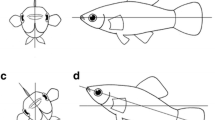Abstract
Information on mating behaviour in Anomopoda isavailable for very few species only, though matelocation and recognition certainly play an importantrole in maintaining reproductive isolation betweenspecies. Ephippial females and males of Moinabrachiata were observed in a drop of water under amicroscope for 10–20 minutes. Different combinationsof specimens were used, but copulation was onlyobserved when two males and two ephippial females wereplaced together. Males were very active, and oftentried to grasp a female, whereas females usually madeattempts to escape during the entire period of mating.Three phases were recognized: capture, positioning andcopulation. The male captured the female from thedorsal side, then moved to the ventral side and tooka position with its length axis being perpendicular tothat of the female, forming a sort of cross.Thereafter the pair started rotating around the lengthaxis of the female, while the male pushed thepostabdomen into the female‘s brood pouch. Copulationlasted from 16 to 25 seconds. When different kinds offemales were used, males showed preference forephippial females with an empty ephippium and enlargedovaries. Our results indicate that not only visual andtactile cues may be important in identifying speciesidentity and receptivity of the female, but alsochemical signals.
Similar content being viewed by others
References
Brauer, F., 1872. Beiträge zur Kenntniss der Phyllopoden. Sber. kais. Akad. Wiss., Math.-naturw. Kl., Abt. I, 65: 279–291.
Carmona, M. J. & T. W. Snell, 1995. Glycoproteins in daphnids: Potential signals for mating? Arch. Hydrobiol. 134: 273–279.
Cohen, A. C. & J. G. Morin, 1990. Patterns of reproduction in ostracodes: a review. J. crust. Biol. 10: 184–211.
Crease, T. J. & P. D. N. Hebert, 1983. A test for the production of sexual pheromones by Daphnia magna(Crustacea: Cladocera). Freshwat. Biol. 13: 491–496.
Dodson, S. I. & D.G. Frey, 1991. Cladocera and other Branchiopoda. In Thorp, J. H. & A. P. Covich (eds), Ecology and Classification of North American Freshwater Invertebrates. Academic Press, New York: 723–786.
Glatzel, T. & H. K. Schminke, 1996. Mating behaviour of the groundwater copepod Parastenocaris phylluraKiefer, 1938 (Copepoda: Harpacicoida). Contributions to Zoology 66: 103–108.
Gordo, T., L. M. Lubián & J. P. Canavate, 1994. Influence of temperature on growth, reproduction and longevity of Moina salina Daday, 1888 (Cladocera, Moinidae). J. Plankton Res. 16: 1513–1523.
Goulden, C. E. 1966. Co-occurrence of moinid Cladocera and possible isolating mechanisms. Verh. int. Ver. Limnol. 16: 1669–1672.
Goulden, C. E., 1968. The systematics and evolution of the Moinidae. Trans. am. phil. Soc. N.S. 58: 1–101.
Gravier, C. & P. Mathias, 1930. Sur la reproduction d’un Crustacé Phyllopode du groupe des Conchostracés (Cyzicus cycladoides (Joly)). C.R. acad. Sci. Paris 191: 183–185.
Grosvenor, G. H. & G. Smith, 1913. The life-cycle of Moina rectirostris. Quart. J. microsc. Sci. 58: 511–522.
Jurine, L., 1820. Histoire des Monocles, qui se trouvent aux environs de Genève. J. J. Paschoud, Paris, 260 pp.
Larsson, P. & S. Dodson, 1993. Chemical communication in planktonic animals. Arch. Hydrobiol. 129: 129–155.
Martin, J. W., B. E. Felgenhauer & L. G. Abele, 1986. Redescription of the clam shrimp Lynceus gracilicornis(Packard) (Branchiopoda, Conchostraca, Lynceidae) from Florida, with notes on its biology. Zool. Scr. 15: 221–232.
Mathias, P., 1937. Biologie des Crustaces Phyllopodes. Hermann & Cie, Paris, 107 pp.
Müller, O. F., 1785. Entomostraca seu Insecta Testacea, quae in aquis Daniae et Norvegiae reperit, descripsit et iconibus illustravit. Lipsiae et Havniae, 135 pp.
Scharfenberg, U., 1911. Studien und Experimente über die Eibildung und den Generationszyklus von Daphnia magna. Int. Revue ges. Hydrobiol. Hydrogr. 3, Biologisches Supplement, 42 pp.
Scourfield, D. J., 1905. Die sogenannten Riechstäbchen bei den Cladoceren. Forschungsber. biol. Stat. Plön 12: 340–353.
Shan, R. K., 1969. Life cycle of a chydorid cladoceran, Pleuroxus denticulatusBirge. Hydrobiologia 34: 295–302.
Smirnov, N. N., 1971. Chydoridae fauny mira. Fauna SSSR. Nov. Ser. No. 101. Rakoobraznyye. Volume 1. vyp. 2, 531 pp.
Snell, T. W. & P. D. Morris, 1993. Sexual communication in copepods and rotifers. Hydrobiologia 255/256: 109–116.
Snell, T. W. & M. J. Carmona, 1994. Surface glycoproteins in copepods: potential signals for mate recognition. Hydrobiologia 292/293: 255–264.
Weismann, A., 1880. Beiträge zur Naturgeschichte der Daphnoiden. VI. Samen und Begattung der Daphnoiden. Z. wiss. Zool. 33: 55–256.
Author information
Authors and Affiliations
Rights and permissions
About this article
Cite this article
Forró, L. Mating behaviour in Moina brachiata (Jurine, 1820) (Crustacea, Anomopoda). Hydrobiologia 360, 153–159 (1997). https://doi.org/10.1023/A:1003105016758
Issue Date:
DOI: https://doi.org/10.1023/A:1003105016758




